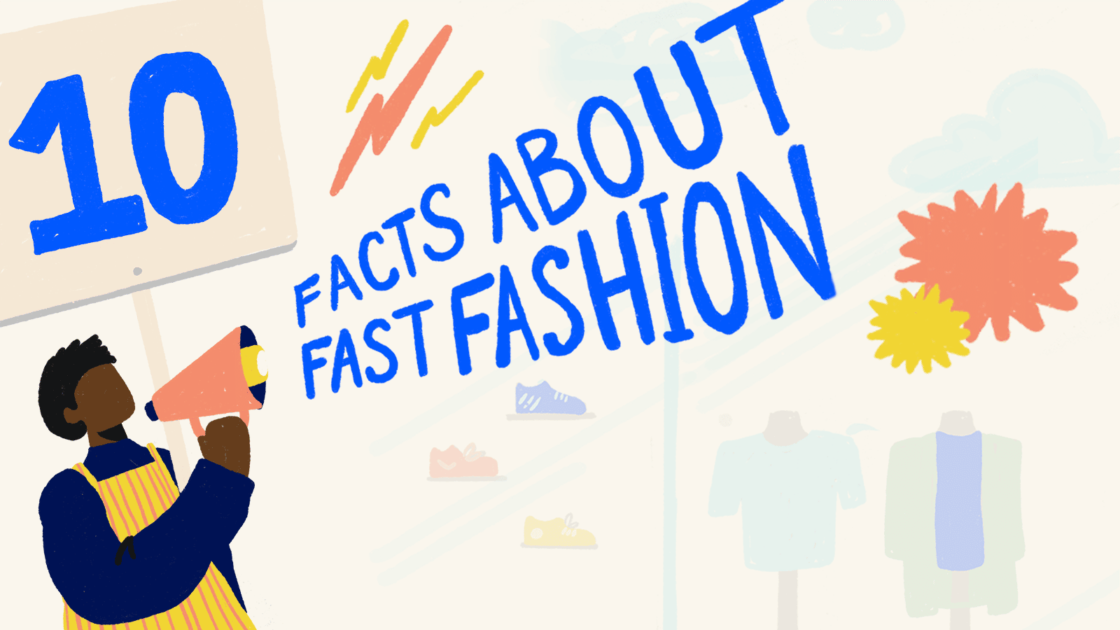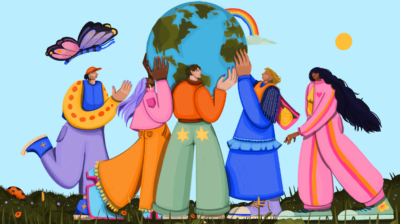10 facts about fast fashion
Fast fashion is one of the most environmentally damaging in industries in the world. Click here to find out 10 reasons why.


Fast fashion is a huge topic, covering everything from our relationship with waste, the impact of the fast fashion industry on climate change, to workers rights. The fast fashion industry is also one of the most profitable industries in the world, as well as one of the most environmentally damaging industries.
It can be easy to lose sight of the big picture when trying your best to be sustainable. However, we all wear clothes, so we all have a role to play when it comes to moving towards a better, more environmentally friendly fashion industry.
10 facts about fast fashion
Here are 10 facts to remember about fast fashion and making more ethical clothing choices:
1. Fast fashion is damaging to our planet
The fast fashion industry has a negative impact on our environment. Fast fashion clothes are often made with toxic dyes and use an excessive amount of water. These toxic chemicals often end up being released out to the areas surrounding the factories, damaging the local environment and threatening the health of the communities who live near these factories, as well as local wildlife and ecosystems.
Many of the clothes produced by these brands also contribute to microplastics in our oceans, because each time we wash materials like polyester or nylon, tiny particles of plastic are released and can be washed into our waterways, impacting on wildlife and nature.
2. Fast fashion brands are contributing to climate change
The global fashion industry produced around 2.1 billion tonnes of Greenhouse Gas emissions in 2018, equalling 4% of the global total. This is because of the ways that brands source their materials, and because the clothes are often made far away from where they are sold. Producing one item of clothing can also involve a lot of travel back and forth between different factories and production lines.
3. Fast fashion brands often do not treat their factory workers well
Factory workers making the clothes that fast fashion brands sell are often in countries with few labour protections and are paid very low wages (around €2 a day in some cases, according to the Clean Clothes Campaign). Their health is also at risk because toxic chemicals and dyes are not disposed of in a safe way.
Some fashion brands will claim that they are not responsible for the treatment of factory workers, apparel and chemical waste from factories that enter the environment. However, those brands have buying power and they have a choice.
4. Improving factory conditions would not raise the price of clothes
According to the Clean Clothes Campaign, wages for garment workers are rarely more than 3% of the price you pay in the shop. Increasing wages would not impact the price of individual garments, it would just reduce the profit for the company (which is around 59% of the retail price of a garment). And if retailers bumped the price to accommodate for a living wage, it would only add an extra 1% on to the cost of the retail price.
5. Sweatshops are never necessary
Some fashion companies justify their treatment of workers by claiming they’re offering jobs in a place where there is little work available. However, this does not excuse the exploitation and poor treatment of workers. Clothing companies have a choice to improve their standards. If more companies placed workers rights and environmental protection above profit, then factories would be forced to have higher standards.
6. Fast fashion companies always prioritise their profits
Fast fashion companies are interested in making profit, not helping local communities. If they did, workers would be paid a living wage and the chemicals from wastewater would not flow untreated into surrounding streets and waterways. Often, when wages increase or the standard of labour rights improves, brands move on to another country where they can continue cheap production.
7. It’s not sustainable just because the label says so
More and more fashion brands are releasing ‘sustainable’ lines – a sign that campaigning by sustainable fashion activists is having an impact. However, many fast fashion brands are using this as a marketing ploy to sell more clothes rather than actually improving their standards and practices. This is known as greenwashing – when a company claims to be more sustainable than they actually are.
In order to know if something is truly sustainable, it might require research into how it was made. It’s also worth asking why brands are bringing out single ‘sustainability’ lines, rather than working to change their systems and practices overall to make everything they sell more sustainable.
8. Throwing away the fast fashion clothes you own is not the answer
In an effort to live more sustainably and use fewer items, many people try to take a minimalist approach, which involves getting rid of anything you don’t really need, and keeping the things that you do need. Creating a capsule wardrobe, which means reducing the amount of clothes in your closet down to a handful of staple items that you can wear again and again, is one way to be more minimalist.
However, the journey towards a capsule wardrobe often starts with throwing out anything you don’t want to keep, but this is not the most sustainable approach. Instead, it’s better to find creative ways to use what you have in your closet instead of automatically getting rid of it. You could pair items you never thought of putting together, use accessories, upcycle your old clothes into a trending style, or try fabric painting, tye-dying or bleaching. You could also use t-shirts and other old clothes as rags for cleaning.
9. Donating or selling clothes is not always sustainable
Donating or selling clothes is much better than putting them in the bin, but this comes with its own complications. First of all, not everything that gets donated is suitable, which means the charity shop or clothing bank you donated to may have no choice but to throw it out. There’s a chance it could also be sent abroad to be sold in other countries where it may still end up in landfill. Globally, less than 1% of clothes are actually recycled into other forms of clothing, according to the Ellen MacArthur Foundation, which means clothing that goes for recycling ends up being down-cycled (for things like insulation), landfilled or incinerated.
There is also the issue of ‘flipping’ second hand clothing in order to make more money. This is when people purchase second-hand or vintage clothes for a low price, but then sell them on at a higher price. This will often involve altering plus-size clothing to fit smaller sizes – making it harder to find larger items in charity shops, more expensive for plus-sized people to buy second hand, and ultimately makes second hand shopping less accessible.
Donating your old clothes is still an important part of creating a more sustainable fashion industry, but it’s worth remembering that it’s not always as simple as it seems. Although it can be disheartening, pushing for a more sustainable, circular fashion model is one way to take action.
10. The best way to be sustainable with your clothes is to buy less
In Ireland, around 63,000 tonnes of clothing and other textiles are collected as household waste each year and this is processed via waste-to-energy plants or landfills, according to the EPA. While shopping second hand or opting for sustainable materials is great, the best thing you can do when it comes to caring for the planet with your clothes is to buy less. Consuming less is the best way to cut down on the output of waste.
We need to move away from a culture of waste. Think twice before throwing away clothing, could you:
- Repair it?
- Donate it?
- Sell it?
- Upcycle it?
- Recycle it?
How to make more ethical clothing choices
As you can tell, nothing is certain when it comes to sustainable fashion and many people are just trying their best to navigate the path to a better future. There are some great resources like the Good On You app, Fashion Revolution and the Clean Clothes Campaign that can help you stay informed on what is happening in the industry.
While individual efforts are a great place to start, fast fashion companies will always be able to find new customers, and they will continue with their current practices as long as it makes money. This is why there needs to be better regulation on waste management, using renewable energy, sustainable materials, eco labelling on clothing, the right to repair, improved working conditions and wages in order for companies to change.
Read more about making more sustainable clothing choices.
Remember: be kind to yourself
As you continue to learn about the fast fashion industry, you may become overwhelmed by all of the issues that exist. That is completely normal. Remember at the end of the day, doing your best is good enough. There is an issue with transparency in the fashion industry and it will take time to change. Try not to be hard on yourself for not getting it right all the time. Everyone trying to be sustainable is in the same boat, doing their best.
You cannot change the entire industry on your own. This does not mean that your actions don’t make a difference but rather, that they form part of a larger movement. Read more about how to be an activist in sustainable fashion.
Cover image by Cathy Hogan






